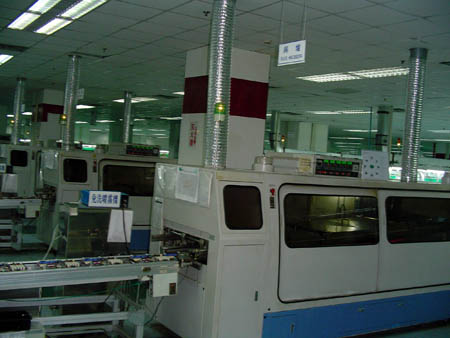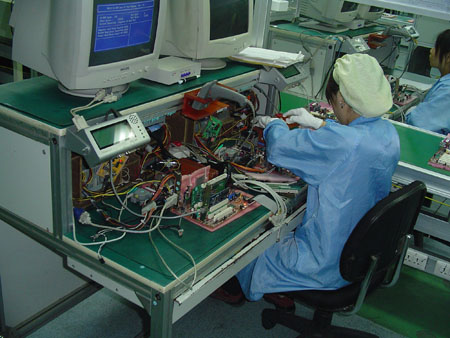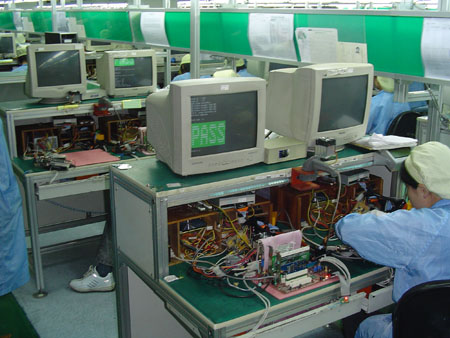The Birth of an Abit NF7 - A Factory Tour
by Kristopher Kubicki on June 11, 2004 10:12 PM EST- Posted in
- Motherboards
Solder
After going through the assembly line, the components just placed on the motherboard are only tacted in place. In order for their transformation to be complete, they must go through an industrial oven so the solder bonds correctly to the board. This is actually the second oven on the production line; the first is used right after SMT.This is actually not an ordinary oven, its a wave solder machine. Wave solder ovens run the motherboard over a molten solder bath in order to melt the fastened components onto the board. You can see a small clip below of the motherboard passing through a final phase in the device. There are two other wave solder machines at Rolly that are completely lead free. Lead free machines use similar assembly techniques, but the solder does not contain any lead (EU legislation requires all electronics imported into the union to be lead-free by 2005). The ovens on those two lines run at different temperatures and look slightly different.
After the oven, a few workers spot solder larger components, which need a little extra to hold in place. Heatsinks and stickers are also placed on the motherboard. Everything else from this point until packaging is quality assurance.
Just like the ECS Shen Zhen facility, each motherboard is completely assembled and booted up to make sure it passes the first stage of quality control. Several custom benchmarks are run, and the system stays on for about two minutes. Each worker works on two motherboards at a time, assembling one while the other is running system diagnostics. It takes less than a minute for each worker to build the entire system.
These boards are only tested once. The workers here will bin bad motherboards into a container, which goes back to the original lab with the oscilliscopes. Good motherboards continue down the line, get scanned into the Oracle database, and are then stamped "OK" to continue on to stress testing or packaging.
However, these motherboards are still not done yet. Out of each batch of 1000 motherboards, 32 are chosen randomly for environmental stress testing, plus a 168-hour burn in. A majority of the other 968 motherboards in the batch are placed into a different testing facility where they will be burned in for 24 hours. Burn in is simply the process of running a benchmark software on the system continuously for an allocated amount of time. Additionally, 10 other motherboards per model per day are selected off the final assembly line and are fully hand-assembled into a PC. Several lucky workers spend the rest of the day making sure UT2K4 (among other software) works correctly with the sampled motherboard.














19 Comments
View All Comments
KristopherKubicki - Sunday, June 13, 2004 - link
Got it, thanks.Kristopher
kalaap - Sunday, June 13, 2004 - link
"This is actually the second over on the production line; the first is used right after SMT."I think you meant second OVEN.
AtaStrumf - Sunday, June 13, 2004 - link
Right Click --> Save Target As... ---> save to disk and play from there. If its still not working you need a new player. Real One Player is preety good.roostercrows - Sunday, June 13, 2004 - link
can someone tell me which video players you guys use? i couldn't get my realplayer to download the videos. thanksDonB - Sunday, June 13, 2004 - link
"...why there are more women than men". Women have much better manual dexterity than men. Remember typing classes in high school? I remember in my class, after the first semester, the females were typing around 40-50 wpm while the males were typing around 25-35 wpm, almost without exception.CurtOien - Sunday, June 13, 2004 - link
"The machine technician and the traditional visual inspectors are paid about the same; usually around $100 per month with lodging."I wonder how much the executives make?
AtaStrumf - Sunday, June 13, 2004 - link
The problem that I see with their testing procedure is that they probably only test at default settings, which is just not good enough for an enthusiast targeted motherboard. Sure my KT7 A worked fine at 100 MHz FSB, but it didn't at 133 MHz FSB, and my latest AN7 works fine at default BIOS setting, but when you change something strange things start to happen.I understand that they're in a hurry, but they should at least test at the most stressful settings that the mobo is supposed to function properly i.e. 200 MHz FSB and not 133 or. 166 MHz. What good is a 24 h burn-in test if it's done at 133 MHz FSB, and I'm gonna be using a 200 MHz FSB.
For instance this AN7 that I have now, works perfectly if I OC my 2500+ with the default offered 3200+, but if I change the FSB manualy to 200 its totaly unstable. How strange is that?
KristopherKubicki - Sunday, June 13, 2004 - link
artifex: I have not heard that reason for using women over men in facilities.What other economic information were you interested in? I can add it to the article.
Kristopher
artifex - Sunday, June 13, 2004 - link
I couldn't get the n7_fail image to load (ironic), but other than that, everything was good.Is it still true that another reason why there are more women than men on the assembly line is because womens' hands are generally thought to be smaller, and more adept?
I'd like to see more of the background economic information like what you provided for this story, next time you do a plant tour, too.